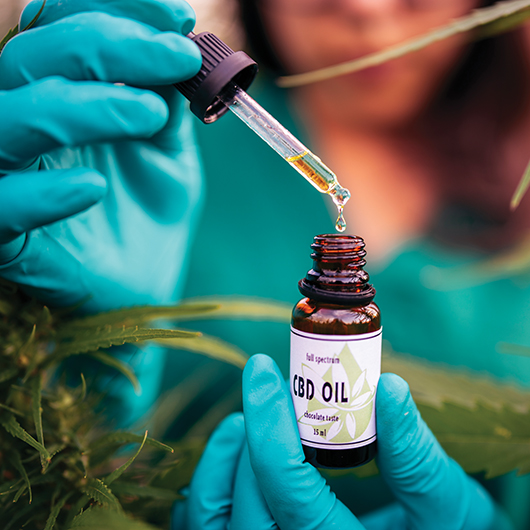Is the drive to legalization slowing?
Whether yes or no, the market grows
By Joseph S. Harrington, CPCU
Not long ago, it appeared that the march to legalized recreational use of cannabis was inexorable. At the outset of 2025, that no longer seems so certain.
Among other things, ballot initiatives to legalize use of cannabis failed in Florida, North Dakota, and South Dakota in 2024. (The measure won a majority in Florida but came short of the threshold needed for passage.)
It was notable that both major presidential candidates indicated some degree of support for removing cannabis from the federal government’s list of “Schedule 1” controlled substances, but doing so never seems to become a priority in divisive D.C. politics.
So, the cannabis landscape continues to be a patchwork of divergent state policies under the shadow of federal illegality. Bullish expectations for legalization have been tempered.
Product growth
Yet, the cannabis business continues to grow as cannabis extracts are incorporated into a wider range of beverages, edibles, and other products. Various sources estimated the size of the U.S. cannabis market at about $33 billion in 2023, with predictions that it will at least double in volume by the end of the decade.
“While growth has been impressive in recent years, we’re beginning to see signs of contraction. However, we will likely still see an influx of activity in states where use was legalized (before 2024), presenting fresh opportunities for businesses that can move quickly to capitalize on these emerging markets.”
—Corey Tobin
Director
Symphony Grow

“The cannabis market is at an inflection point,” says Corey Tobin, director of Symphony Grow, the specialty insurance business of Symphony Risk Solutions. “While growth has been impressive in recent years, we’re beginning to see signs of contraction.
“However, we will likely still see an influx of activity in states where use was legalized (before 2024), presenting fresh opportunities for businesses that can move quickly to capitalize on these emerging markets.
“Success will favor those who focus on sustainability over hype.”
Andor Tobelem, vice president of Miami Insurance Brokers, who sells cannabis coverage, sees little sign of slowing growth, as cannabis producers are still busy expanding into states where recreational use has been legalized.
“Established cannabis product manufacturers are expanding into these new states,” he says. “I expect the trend to continue, especially as the insurance industry now offers appropriate coverages for most of the exposures facing producers and retailers.”
Adding CBD and THC
Thaer Hidmi, a senior underwriter with London Underwriters, which sells cannabis coverage in the United States, says continued growth can be expected in the cannabis insurance market, both from increased legalization and from the development of new types of cannabis products.

“The development of products containing CBD and THC has definitely increased interest in cannabis-based products and increased the consumer count by a large margin,” Hidmi says. “This results in additional exposure that leads growers, distributors, and retailers to seek more insurance coverage.”
(CBD is a non-intoxicating substance found in cannabis that has been added into drinks for 10 to 15 years, while THC is an intoxicating cannabis extract introduced into beverages more recently. Debate continues about the health risks and benefits of CBD and THC.)
Tobelem concurs. “New types of cannabis products are certainly affecting the business,” he says. “These products are hitting the shelves at retail stores that do not focus on selling cannabis products. Most of these merchants do not carry coverage for these products and most will have specific cannabis exclusions on their general liability policies.”
Whether it’s growing rapidly or slowly, the cannabis business is “maturing” in its outlook toward risk management and insurance, according to Tobin.
“Innovative products such as CBD- and THC-infused beverages are shaking up the market and bringing new complexities to the insurance landscape,” he says. “I’m encouraged to see more cannabis companies viewing their brokers as strategic advisors rather than transactional vendors. This shift indicates a maturing industry where companies prioritize risk management.
“For businesses developing cutting-edge products, having a broker who understands that isn’t a luxury—it’s a necessity.”
Complex and specialized
Even without its ambiguous legal status, cannabis presents a diverse and specialized set of exposures often combined within vertical enterprises.
“Cultivators, processors, distributors, and transporters all have distinct risk exposures,” Tobin says. “Cultivation facilities face potential losses from equipment breakdown or crop damage, while transportation companies deal with theft or accidents during delivery.”
As for first-party property insurance, Tobin says it is crucial for agents and brokers to secure coverage extensions for equipment breakdown and business interruption for their cannabis clients. He adds that producers can expect to engage in “creative negotiation” to reduce the impact of limitations and exclusions for losses due to fire, theft, and crop perils.
Tobelem finds that many cannabis vendors are not aware of their ability to insure the finished stock they have on hand to sell. “When insurers first began to cover cannabis businesses, coverage for finished stock was not an option,” he explains. “Many cannabis operations continue to go without finished stock covered because they are unaware stocks are now insurable by option.”
Liability coverage is the primary concern of cannabis enterprises, according to Hidmi. “The products/completed ops coverage is very important,” he says, “due to any harm to users that can be caused by the products themselves.”
Tobin finds products liability for cannabis to be “relatively quiet” in terms of claims frequency but cautions that insurers are “keeping a close eye on a few high-profile cases” to assess potential for claim severity. In a related area, however, Tobin says cannabis insurers are seeing a growing number of product recall claims in response to heightened regulatory scrutiny of cannabis operations.
Whether it’s growing rapidly
or slowly, the cannabis business is
“maturing” in its outlook toward risk management and insurance.
Professional liability
Given the unique legal and regulatory challenges of the cannabis sector, Tobin believes that many cannabis operators are underinsured for professional liability. We don’t normally think of retailers needing errors and omissions coverage, but cannabis merchants operate in what might be considered a middle ground between liquor vendors and pharmacists.
Unless it’s a craft brewery, distillery, or winery, products liability is not an immediate concern for someone who sells “packaged” liquor labeled by its producer. It helps if an alcohol vendor can describe and recommend certain types of wine and other beverages, but it’s not essential and carries no standard of care.
Pharmacists, on the other hand, have direct liability for dispensing controlled substances as prescribed by licensed physicians, and often provide informal advice regarding use of “over the counter” medications. The latter doesn’t necessarily imply professional liability but could be actionable if undertaken recklessly.
For practical purposes, cannabis merchants are expected to have a level of understanding of their products beyond that of a liquor store merchant, but not to the degree of a licensed pharmacist. There is clearly some exposure for professional liability; the degree of exposure will be determined through the course of litigation now underway.
“The development of products containing CBD and THC has definitely increased interest in cannabis-based products and increased the consumer count by a large margin. This results in additional exposure that leads growers, distributors, and retailers to seek more insurance coverage.”
—Thaer Hidmi
Senior Underwriter
London Underwriters

Pharmacists, on the other hand, have direct liability for dispensing controlled substances as prescribed by licensed physicians, and often provide informal advice regarding use of “over the counter” medications. The latter doesn’t necessarily imply professional liability but could be actionable if undertaken recklessly.
For practical purposes, cannabis merchants are expected to have a level of understanding of their products beyond that of a liquor store merchant, but not to the degree of a licensed pharmacist. There is clearly some exposure for professional liability; the degree of exposure will be determined through the course of litigation now underway.
Exposures of others
As commerce in cannabis expands both horizontally (through legalization) and vertically (through product development), non-cannabis businesses are facing growing exposure to cannabis-related claims.

“Established cannabis product manufacturers are expanding into … new states. I expect the trend to continue, especially as the insurance industry now offers appropriate coverages for most of the exposures facing producers and retailers.”
—Andor Tobelem
Vice President
Miami Insurance Brokers
“The development of new cannabis-infused products is certainly impacting non-cannabis accounts,” says Tobelem. “As these products hit the shelves of non-cannabis retailers, most insurance carriers are adding exclusions for them to their general liability and businessowners policies.”
Hidmi finds that “a lot of carriers are declining to write any risks that involve cannabis, including lessor’s risks with any exposure for tenants or products that involve cannabis. They will either decline to write an account or apply an exclusion to any cannabis-related exposures.”
Despite these obstacles, a diligent producer can find coverage for such accounts, says Tobin. “These operations—whether they’re providing packaging, technology, or consulting services—can secure comprehensive coverage for cannabis exposures provided they implement proper risk controls,” he says.
“We’ve had great success placing coverage with top-tier carriers for accounts that are ancillary to the cannabis sector,” Tobin adds. “With the right guidance, these ancillary businesses can thrive without compromising on their insurance needs.”
For more information:
London Underwriters
londonuw.com
Miami Insurance Brokers
mibrk.com
Symphony Grow
symphonyrisk.com/solutions/symphony-grow
The author
Joseph S. Harrington, CPCU, is an independent business writer specializing in property and casualty insurance coverages and operations. For 21 years, Joe was the communications director for the American Association of Insurance Services (AAIS), a P&C advisory organization. Prior to that, Joe worked in journalism and as a reporter and editor in financial services.






